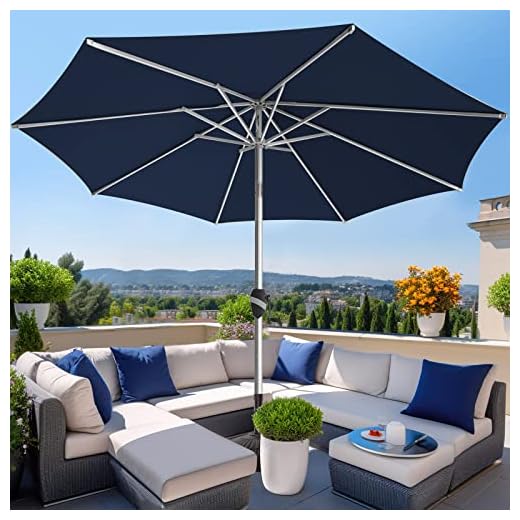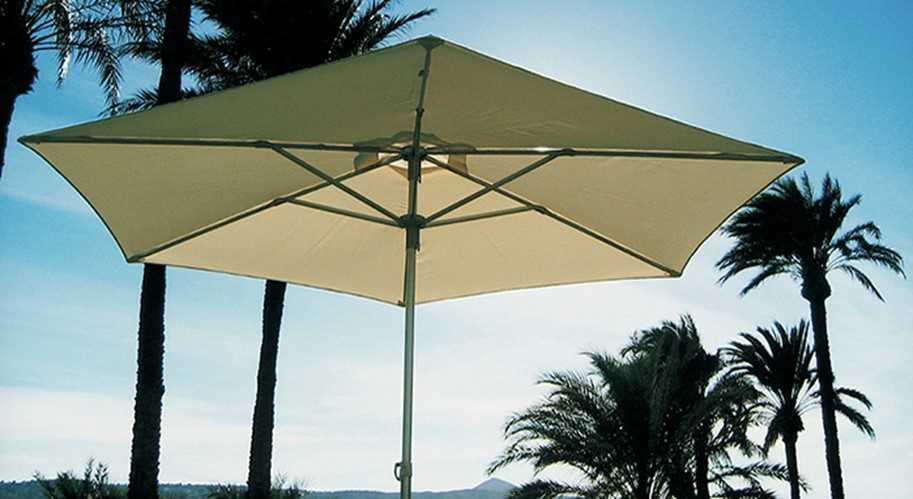




Choosing a sturdy canopy is vital for enjoying outdoor spaces, especially in breezy environments. This article explores various options that provide stability and durability, ensuring your outdoor shade remains intact when the wind picks up.
Individuals seeking to enhance their outdoor experience will find this information particularly valuable. Whether you’re a homeowner looking to beautify your patio or a business owner aiming to create a comfortable outdoor seating area, understanding how to select the right shade solution is key.
We’ll discuss the materials, structure types, and anchoring techniques that are most effective in resisting strong gusts. By the end of this piece, you’ll be equipped with the knowledge to make an informed choice, ensuring your outdoor setup stays secure, no matter the weather.
Best Patio Umbrella Design for Wind
When selecting a shade solution that can withstand gusty conditions, focus on specific features that enhance stability. Look for a robust frame made from materials such as aluminum or fiberglass, which provide strength without excessive weight. Additionally, a weighted base is essential; it should be sufficient to anchor the structure securely.
The canopy’s shape plays a significant role in resilience against breezy weather. Opt for designs with a rounded or aerodynamic profile, as they allow wind to flow over rather than catch. Ventilation is another key aspect; a model with built-in air vents will reduce pressure and minimize the risk of inversion during strong gusts.
Key Features to Consider
- Frame Material: Choose aluminum or fiberglass for durability.
- Base Weight: Ensure the base is heavy enough to prevent tipping.
- Canopy Shape: Look for rounded or aerodynamic designs.
- Ventilation: Models with air vents reduce wind pressure.
- Adjustability: A tilting mechanism can help position the canopy away from direct wind.
Implementing these features will significantly enhance the longevity and functionality of your shade structure in challenging weather conditions. Prioritize these elements during your selection process to ensure a more reliable outdoor experience.
Choosing the Right Frame Material for Wind Resistance
Aluminum is a preferred choice for durable frameworks that can withstand strong gusts. Its lightweight nature allows for easy handling, while its resistance to rust ensures longevity even in harsh weather conditions. Aluminum frames often come with a powder-coated finish, providing additional protection against the elements.
On the other hand, steel frames offer superior strength and stability. Galvanized steel is particularly effective in resisting corrosion and can endure higher wind speeds. However, the increased weight of steel may make repositioning more challenging. Consider the balance between weight and sturdiness when selecting the material.
Factors to Consider
- Weight: Heavier materials tend to resist being blown away more effectively.
- Durability: Look for materials that can withstand rust and corrosion for long-term use.
- Design: Some frames allow for added flexibility, which can be beneficial in high winds.
Ultimately, the right choice depends on specific environmental conditions and personal preferences. Evaluate the typical wind patterns in your area and select a frame material that aligns with those conditions to ensure stability and safety.
Aerodynamic Canopy Shapes for Enhanced Stability
A canopy with aerodynamic shapes significantly improves stability during breezy conditions. Designs that incorporate streamlined profiles help reduce wind resistance, allowing the structure to withstand gusts more effectively.
Canopies featuring a dome or arc shape are particularly beneficial. These profiles allow wind to flow smoothly over the surface, minimizing turbulence and potential lift. Structures with flat or square canopies may catch the wind more readily, making them less stable.
Benefits of Streamlined Canopy Profiles
- Reduced Wind Load: Aerodynamic shapes lower the force exerted by the wind, preventing the canopy from becoming dislodged.
- Improved Durability: Designs that distribute stress evenly across the frame enhance longevity, reducing wear and tear.
- Enhanced Aesthetic Appeal: Sleek profiles can complement outdoor settings, providing both functionality and visual appeal.
Incorporating features such as vents can further enhance performance. These openings allow air to escape, reducing pressure buildup under the canopy and enhancing overall stability during gusty conditions.
- Consider Ventilation: Choose designs with built-in vents to allow airflow.
- Frame Strength: Opt for robust materials that can withstand stress and pressure.
- Weight Distribution: Ensure the frame supports the canopy evenly to prevent tipping.
Ultimately, selecting a canopy with aerodynamic properties can significantly contribute to stability and longevity, making it a wise investment for outdoor areas.
Weight and Base Options to Secure Your Umbrella
Choosing the right weight and base for your outdoor shade structure is vital for stability. Heavy-duty bases typically provide the necessary support to withstand gusts, while lighter options may require additional measures to ensure safety.
Common materials for bases include concrete, steel, and resin. Concrete bases offer the most stability due to their weight, while steel can provide a solid option with a sleek design. Resin bases are often more portable and can be filled with water or sand to increase weight, making them versatile for different environments.
Base Types
- Free-standing Bases: Ideal for versatility, these bases can be moved easily and often come in various designs.
- Table Bases: These integrate with outdoor furniture, providing stability while saving space.
- In-ground Options: Perfect for permanent installations, these provide excellent resistance to strong winds.
Weight requirements depend on the size and height of the shade structure. A general rule is to use at least 10-15 pounds of weight per foot of the structure’s height. For example, a 7-foot structure should have a base weighing at least 70-105 pounds.
Consider the environmental conditions in your area. If you experience frequent strong winds, opting for heavier bases and secure anchoring methods will enhance stability. Regularly check the base for wear and tear to maintain safety.
| Base Type | Material | Weight (Approx.) |
|---|---|---|
| Free-standing | Concrete | 50-100 lbs |
| Table | Steel | 30-60 lbs |
| In-ground | Concrete | Varies |
Innovative Features to Consider for Windy Conditions
Choosing a canopy that withstands strong breezes requires careful attention to specialized features. Opt for a model equipped with a vented canopy that allows wind to pass through instead of creating lift. This design minimizes the risk of overturning during gusts.
Another crucial aspect is the weight of the base. A heavier base ensures stability, preventing the structure from being easily moved by strong winds. Consider bases made from materials like concrete or steel, which provide enhanced support.
- Wind-Resistant Framework: Look for canopies with reinforced ribs and a sturdy frame, often made from aluminum or fiberglass, designed to endure harsh conditions.
- Adjustable Tilt Mechanism: This allows you to change the angle of the canopy to better shield against shifting wind directions.
- Quick-Release Mechanism: Enables rapid folding and securing of the canopy during severe weather changes, enhancing safety and longevity.
- Durable Fabrics: Choose UV-resistant and water-repellent materials to ensure the canopy remains intact and functional despite exposure to the elements.
- Smart Anchoring Systems: Some models come with innovative anchoring solutions, like ground stakes or weighted bags, to improve stability.
By focusing on these features, it is possible to enhance the durability and safety of outdoor shade structures, ensuring they remain functional and secure even in blustery conditions.
Best patio umbrella design for wind
Features
| Part Number | 1 |
| Model | wikiwiki |
| Warranty | 1 year |
| Color | Beige |
| Release Date | 2023-03-22T00:00:01Z |
| Size | 9 FT |
Features
| Part Number | 4336583223 |
| Model | 4336583223 |
| Color | TAN |
| Size | 9 FT |
Features
| Part Number | W1-6-9 |
| Model | W1-6-9 |
| Color | Navy Blue |
| Size | 9 FT |
Features
| Part Number | SKY5897 |
| Model | SKY5897 |
| Color | Black |
| Size | Set of 1 |
Video:
FAQ:
What features should I look for in a patio umbrella designed for windy conditions?
When selecting a patio umbrella that can withstand wind, consider the frame material, canopy fabric, and base weight. A sturdy frame made from materials like aluminum or fiberglass provides durability. Look for a canopy made from wind-resistant fabric, such as polyester or acrylic, which can withstand stronger gusts. Additionally, a heavier base will help anchor the umbrella firmly, preventing it from tipping over in strong winds.
Are there specific umbrella shapes that perform better in windy weather?
Certain shapes of patio umbrellas are better suited for windy conditions. For example, a market umbrella with a round canopy can deflect wind more effectively than square or rectangular models. Additionally, a cantilever umbrella, which is offset from the base, can be more stable in windy environments since it allows wind to pass underneath without creating excessive lift. It’s also helpful to choose a canopy with a vented design, which allows wind to escape and reduces the risk of the umbrella being blown away.
How can I secure my patio umbrella to prevent it from blowing away?
To secure your patio umbrella, start with a heavy and stable base that can withstand strong winds. You can also use additional weights, such as sandbags or bricks, around the base for extra stability. In very windy conditions, consider lowering the umbrella or collapsing it entirely to prevent damage. Some patio umbrellas come with tie-down systems or straps that can be used to secure the umbrella to a fixed structure, adding another layer of safety.
What is the best material for a patio umbrella that will be used in windy areas?
The best materials for a patio umbrella in windy areas include a strong aluminum frame, which is lightweight yet durable, and a canopy made from high-quality acrylic or polyester fabric. These materials are not only resistant to fading and wear but also provide better wind resistance. Additionally, look for umbrellas with reinforced seams and stitching, as these features enhance the overall strength and longevity of the product in windy conditions.
Can I customize my patio umbrella for wind resistance?
Yes, many manufacturers offer customization options for patio umbrellas that can enhance their wind resistance. You can choose stronger materials, different shapes, and various base weights. Some companies even provide options for vented canopies, which help reduce wind lift. Before customizing, it’s a good idea to consult with the manufacturer or retailer to ensure that your selections will effectively improve the umbrella’s performance in windy conditions.







